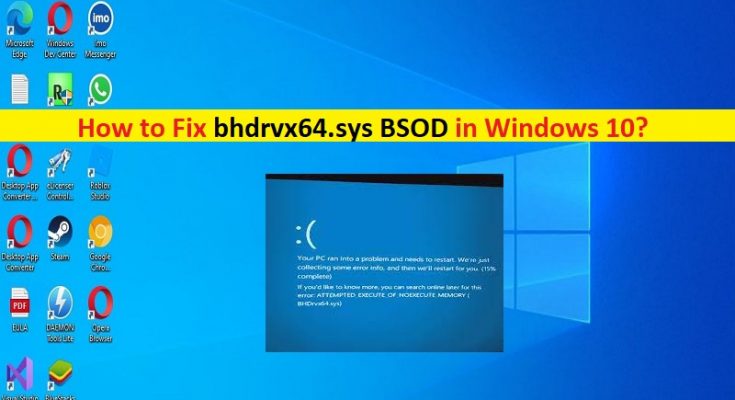What is ‘bhdrvx64.sys BSOD’ in Windows 10/11?
In this article, we are going to discuss on How to fix bhdrvx64.sys BSOD in Windows 10/11. You will be guided with easy steps/methods to resolve the issue. Let’s starts the discussion.
‘bhdrvx64.sys BSOD’ error: bhdrvx64.sys process is driver for Windows Operating System. It is also known as BASH Driver or Symantec Heuristics Driver which belongs to BASH Software for Utility Common Driver developed by Symantec. However, several Windows users reported they faced bhdrvx64.sys BSOD error on their Windows 10/11 computer in the middle of their work on computer or when they start/restart their computer.
It is common Windows Problem considered as Blue Screen of Death (BSOD) error. This error is appeared with message saying ‘Your PC ran into a problem and need to restart. We’re just collecting some error info, and then we’ll restart for you’. There could be several reasons behind the issue including corrupted system files or registry, or system image, malware or viruses infections in computer, outdated/corrupted device drivers, outdated Windows OS, problematic software installed or problematic hardware attached into computer, and other Windows issues.
You should make sure all device drivers are properly installed in computer and are up-to-date to latest & compatible version in computer. Also, make sure Windows OS is up-to-date to latest version in computer if you don’t want this type of issue. It is possible to fix the issue with our instructions. Let’s go for the solution.
How to fix bhdrvx64.sys BSOD error in Windows 10/11?
Method 1: Fix bhdrvx64.sys BSOD error with ‘PC Repair Tool’
‘PC Repair Tool’ is easy & quick way to find and fix BSOD errors, DLL errors, EXE errors, problems with programs/applications, malware or viruses issues, system files or registry issues, and other system issues with just few clicks.
Method 2: Update Windows 10 OS

Updating Windows OS to latest version can resolve the issue.
Step 1: Open ‘Settings’ app in Windows PC via Windows Search Box and go to ‘Update & Security > Windows Update’ and click ‘Check for updates’ button
Step 2: Download and install all available updates in computer, and once installed, restart your computer and check if the issue is resolved.
Method 3: Run SFC scan and DISM scan
You can run SFC scan and DISM scan in computer to repair the corruption in system files and system image and fix the issue.
Step 1: Press ‘cmd’ in Windows Search Box and press ‘SHIFT + ENTER’ keys on keyboard to open ‘Command Prompt as Administrator’
Step 2: Type the following commands one-by-one and hit ‘Enter’ key after each to execute.
sfc /scannow
DISM /Online /Cleanup-Image /CheckHealth
DISM /Online /Cleanup-Image /ScanHealth
DISM /Online /Cleanup-Image /RestoreHealth
Step 3: Once executed, restart your computer and check if the issue is resolved.
Method 4: Update Device Drivers
Updating all necessary device drivers to latest & compatible version can resolve the issue. You can try updating all Windows drivers using Automatic Driver Update Tool. You can get this tool through button/link below.
Method 5: Perform System Restore

If the issue is still persist, you can restore your computer to valid restore point when there was no issue at all in computer.
Step 1: Press ‘Windows + R’ keys on keyboard, type ‘rstrui’ in ‘Run’ window and hit ‘Ok’ button to open ‘System Restore’ app
Step 2: Click ‘Next’, select a valid restore according to date & time when there was no issue at all in computer, and click ‘Next > Finish’ to start restoring process. Once finished, restart your computer and check if the issue is resolved.
Method 6: Uninstall third-party antivirus/firewall program
This issue can be occurred due to interference of third-party antivirus/firewall program installed in computer. You can uninstall third-party antivirus/firewall in computer in order to fix.
Step 1: Open ‘Settings’ app in Windows PC and go to ‘Apps > Apps & Features’
Step 2: Find and right-click on your third-party antivirus/firewall, and select ‘Uninstall’ to uninstall it
Step 3: After uninstall, restart your computer and check if the issue is resolved.
Method 7: Perform Windows OS repair or Clean Windows OS installation
You can perform Windows OS repair using Windows Installation Media USB to repair your computer and check if it works for you. If not, you can use the same Windows Installation Media USB to perform clean Windows OS installation to fix the issue.
Conclusion
I am sure this post helped you on How to fix bhdrvx64.sys BSOD error in Windows 10/11 with several easy steps/methods. You can read & follow our instructions to do so. That’s all. For any suggestions or queries, please write on comment box below.



